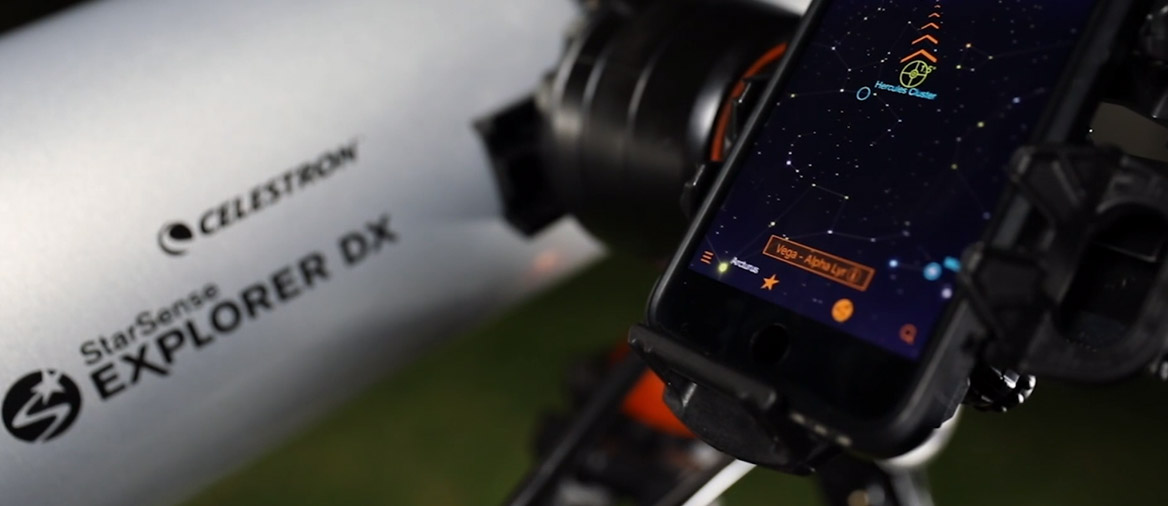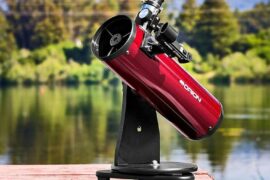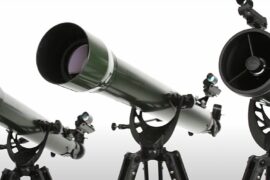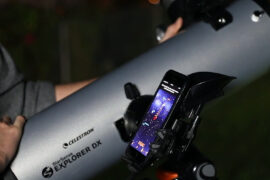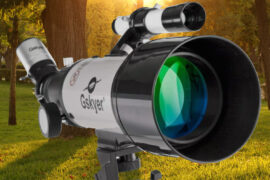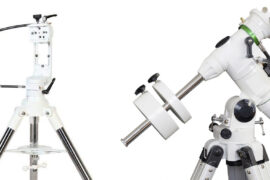Reflector telescopes (also referred to as Newtonian or reflecting telescopes) are a great choice for beginners looking to get into stargazing.
They offer the most power for the less amount of money out of all the popular designs on the market. As a matter of fact, this is the reason why the large telescopes found in observatories, and even space telescopes like the Hubble and the James Webb, are in essence, reflectors.
But there’s a wide variety of them out there, and choosing which one is the best fit for you can be intimidating with all the different numbers, specifications, and opinions.
I have created this buyer’s guide to help you through the process. By the end of it, you will be able to make an informed opinion and select the best reflector telescope for your needs.
If you don’t want to read through the guide, here’s our best pick, for all the detailed explanations of the selection process, keep reading.
Celestron – StarSense Explorer LT 114AZ

The StarSense technology makes it easy for a beginner to learn. It takes out many of the complications of getting started with stargazing.
The most difficult part of getting started with stargazing is finding the objects you want to look at in the vastness of the night sky. Even using external tools like star maps and simulation apps there’s a lot of trial and error and a learning curve to it that can be frustrating.
The StarSense line of telescopes does a lot to solve this. Here’s how it works.
You download the StarSense app on your phone. Then you attach it to the holder that is in the telescope’s tube. Fire up the app, and follow the instructions so it can triangulate your location. The app will then use its star recognition software to map out the sky you are looking at.
Once that is done, simply select an object out of the database of visible ones for that night and the app will guide you on how to point your telescope to observe it.
This reduces considerably the time spent on star-hopping and figuring out latitudes and position of the stars, and lets you focus on actually observing.
There are several telescopes that include the StarSense tech, but this is a 114mm Newtonian. The optics and build quality are the same as the ones in the Celestron AstroMaster line which are well-known for their reliability in the hobbyist market.
The included Alt-Azimuth mount is easy to use. It is basically “point and shoot” with movement across the vertical and horizontal axis. This is the recommended mount type for beginners but if you are looking for something more precise (but also more complex) like an EQ mount it can be replaced later.
The only area where the Celestron StarSense 114AZ doesn’t shine is in the included accessories. It comes with 25mm, and 10mm Kellner eyepieces as well as a 2X Barlow lens. These are serviceable as a starting kit but at the price point of this telescope, I would hope for Plossl eyepieces instead (Plossl vs Kellner comparison).
In general, you can’t go wrong with any of the StarSense scopes. There is also a 130mm version of this reflector with a slightly better mount if you are looking for more power, but the price jump is a bit high for my taste. In that case, I’d recommend going with the AstroMaster 130EQ which is featured below in this list. You won’t get the benefits of the app but the price point is much more reasonable.
alternative retailer: optcorp
Are reflecting telescopes good for beginners?
Reflecting telescopes are a solid choice for beginner stargazers. They offer multiple advantages against refractors which are the other popular design on the market. Here are some of the characteristics of reflectors:
- Reflecting telescopes use mirrors instead of lenses. This allows them to fix the main optical issues with refractors which are chromatic aberrations (color errors) and spherical aberrations (blurriness around the edges).
- Reflecting telescopes have the best price-per-aperture ratio. This means they generally offer more power for less money.
- They can be manufactured in large sizes.
- Reflecting telescopes grow with you. Even though they have a steeper learning curve, as you learn more you will be able to get more out of them.
- Mirrors are more durable and easier to replace than lenses, making the average lifespan of a reflecting telescope longer.
We have a whole article on the pros and cons of reflecting telescopes that goes into more detail about all these points.
Are Newtonian and reflecting telescopes the same thing?
You will sometimes hear Newtonian and reflecting used interchangeably and this might confuse you.
Newtonian telescopes are reflecting telescopes, but they are only a subset of a larger variety. There are other types of reflectors such as Dobsonians and Cassegrain telescopes.
However, Newtonians are more popular among amateur stargazers than those other types because of their price and availability. As you will see in the list of the best reflector telescopes for beginners below, most of the picks are in fact, Newtonians.
We have an article about the different types of reflecting telescopes if you want to learn more about them.
How to choose a telescope
Choosing a telescope can seem intimidating with all the technical specifications, numbers, and lingo that seem foreign to anyone that doesn’t have any experience in the subject.
But it’s actually not that hard once you learn a couple of basics. Here’s what you need to know in just a few paragraphs.
Aperture
This is almost the only number that you really need to consider when it comes to buying any telescope.
The aperture of a telescope refers to the diameter of the primary mirror. It is usually given in millimeters so it looks something like 70mm, 114mm, 130mm, etc.
When it comes to the aperture, bigger is always better and that is because it determines the maximum amount of light that the device is going to be able to capture. More light results in a sharper, better, and more detailed image.
A large aperture can a lot of times make up for optical issues on a mediocre telescope, but not the other way around. Even the best-manufactured telescope can’t resolve images beyond what its aperture allows it to.
Portability
I know I just told you above to pick the telescope with the largest aperture, but there’s a problem with that. A larger aperture also means a bulkier, heavier, telescope.
Reflecting telescopes are not as portable because of their large mirrors and because moving them constantly will also mean the mirrors will need to be aligned (collimated) more often. They make excellent backyard devices, but carrying them can be a bit of a chore.
With one exception.
Maksutov-Cassegrain telescopes are a type of reflector (technically they are a hybrid, but let’s not get into that for now) that is very portable. They have compact, light tubes that are great for travel and they don’t need to be collimated. If you are looking to take it into the field often, consider one of these. The disadvantage, however, is that they can be considerably more expensive than Newtonians. Here’s an article on Maksutovs vs Newtonians if you want to look deeper into that. Also, if portability is a big factor for you, consider checking out our guide to portable telescopes too.
Focal length
The focal length is the second most important specification of any telescope. It is the distance the light travels from the primary mirror to the exit focuser. Because reflectors bounce the light inside the tube, this distance isn’t equal to the length of the body.
A larger focal length isn’t always better. In fact, a short FL is preferable for some use cases such as astrophotography or deep space viewing because it results in a larger field of view. On the other hand, a large FL is more optimal for planetary viewing.
When choosing a focal length, there isn’t really a wrong answer, but if there is a specific type of object you want to optimize for, choose accordingly. Short for galaxies, nebulae, etc. And long for planets and the Moon.
But don’t worry too much about it, fortunately, there are accessories to increase or decrease the focal length so you will not be completely stuck with the one that your telescope comes with.
Best reflector telescopes for beginners
Best value – Celestron AstroMaster 130EQ
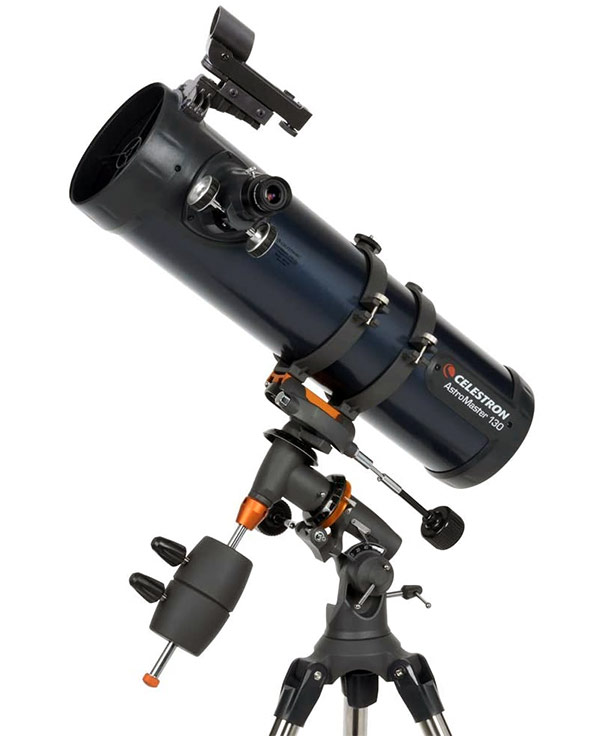
Reliable, good optics and advanced features at a reasonable price.
The Celestron AstroMaster is the most well-known lineup of telescopes on the market and with good reason. They offer great optics, solid build quality, and are available at very reasonable prices.
The AstroMaster 130EQ is the largest reflector in the line. It is a 130mm Newtonian with an equatorial mount.
An aperture of 130mm will allow you to see pretty much every crater on the Moon, some detail on Mars including its poles, the various colors of Jupiter and its largest Moons, and it is the size where you can get enough detail to see clearly the separation between Saturn’s rings and the planet.
This article on what to expect out of a 130mm telescope will give you a better idea of what you will be able to see.
One of the easiest ways to notice the optic quality of a reflector is to take a look at the brightness and contrast of the images it produces. Because reflectors bounce light unlike refractors, some can be lost along the way, producing dimmer images. This is less of a problem in high-quality telescopes with good light transmission where the mirrors are correctly manufactured to reduce this effect. Such is the case of the AstroMaster 130EQ which resolves bright images with good contrast.
The equatorial mount it comes with is more precise and better for tracking than an AZ mount. However, that also makes it harder to use so there’s a bit of a learning curve. The good news is that you know that you will be able to correctly track objects which is great if you ever want to try your hand at astrophotography. There’s also a model of this telescope that comes with a motor drive for easier tracking. I wouldn’t consider it necessary at all, but some people really like it as it means considerably less manual adjusting.
As for accessories, it comes with a red dot finderscope, and two Kellner eyepieces (20mm and 10mm). Some bundles include a Barlow lens but if yours doesn’t, consider grabbing one separately.
To conclude, the AstroMaster 130EQ offers great value for its price. It is priced in the same range as many inferior products and offers much better quality for it. You can’t go wrong with it.
alternative retailer: optcorp
Best views – Orion SkyQuest XT8
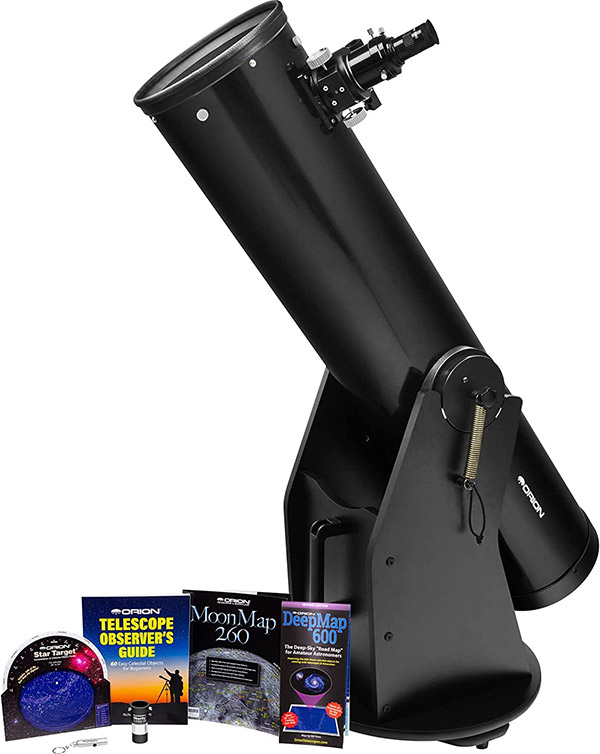
Huge 203mm aperture telescope that is completely built for high power and magnification.
If what you want is maximum power in your telescope and you don’t care about portability or storage space, then look into a Dobsonian telescope.
Dobsonians are a type of large reflector telescope that are also sometimes called “light buckets”. Their design is simple but it focuses on maximizing aperture to suck the most amount of light possible, producing highly detailed images. Dobsonians will get you spectacular views of galaxies, nebulas, and other deep sky objects.
The Orion SkyQuest XT8 is a 203mm (8 inches) classic Dob with a parabolic mirror that produces great images. The optics in this thing are impressive. The level of detail that you can get from Jupiter or Saturn compared to a 130mm Newtonian is very noticeable.
One of the keys to a good Dobsonian is the base. It needs to be stable but at the same time offer soft rotation for tracking and locating objects. Dobsonians use in essence an Alt-Azimuth mechanism that is easy to use but it works a bit differently than the one in tripods.
It comes with a 25mm high-quality Plossl eyepiece which is great. I wish it would at least come with a high-powered 10mm one as well, but at least the one it includes is really good and you will see no need to upgrade it. I’d also recommend grabbing a Barlow lens to compliment it.
It also comes with a red-dot finder and a 2″ focuser. It is important to note here that most eyepieces have a barrel of 1.25″ so they won’t fit at first, but it does come with an adapter. Having the 2″ focuser will allow you to also use 2″ eyepieces in the future which are generally targeted at serious stargazers as they are extremely high-quality but also more expensive.
If what you want is to get the best view you can, I can’t recommend a Dobsonian enough. Some people don’t like them as they are harder to move around and require more cleaning and occasional maintenance, but the images are worth it and they are the cheapest way to get a telescope of such a large aperture. If you don’t think you are ready to invest in a 200mm model like the SkyQuest XT8, there is a smaller model, the XT6 which is 152mm and considerably cheaper.
alternative retailer: optcorp
Best budget pick – ESSLNB 114AZ
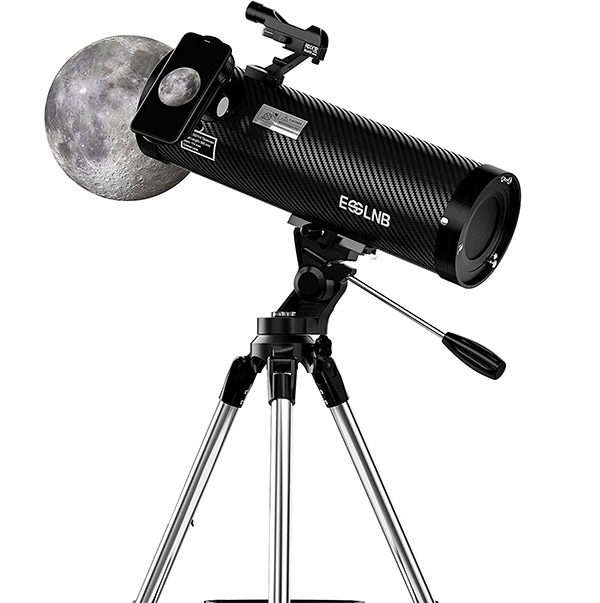
Entry-level telesocpe with decent optics at an excellent price for its size.
If you are on a tight budget there are still good options when it comes to reflectors. As you go lower in price points you will find that companies start to cut corners here and there to cut costs and offer a more attractive price. And while those sacrifices are understandable, they key is to select a telescope that doesn’t sacrifice in the most important area: optics.
This 114mm Newtonian that I picked is manufactured by a company that offers exactly this but made some strange choices when picking its name. The company is ESSNLB
We have reviewed in-depth some ESSLNB products before and found them to be quite good.
The light transmission and quality of the mirrors are really the reason why I chose this. While its nothing spectacular and lacks a bit in terms of contrast, the images are resolved clearly and without artifacts or any noticeable issues. As a beginner, it would be hard for you to find a difference between this and a higher-priced telescope unless you could see both images side by side and really pay attention to the details.
The limitations of this telescope, however, start to show up when you look at the build quality. The included mount feels unstable at times and unless you are planning to use it on a completely flat surface I’d recommend grabbing some tripod rubber feet or something else to add stability.
The included accessories are also very basic. I didn’t even need to open them to notice they are only 2-element eyepieces. And while it does include a Barlow lens and a red dot finder, upgrading the eyepieces could help optimize the views.
This is the kind of telescope I’d recommend if you have a deadline for a gift and a limited budget. Otherwise, I’d recommend you saving a bit more and get one of the other recommended models above.
Enjoyed this article?
Get daily 10-minute PDFs about astronomy to read before bed!
Sign up for our upcoming micro-learning service where you will learn something new about space and beyond every day while winding down.

